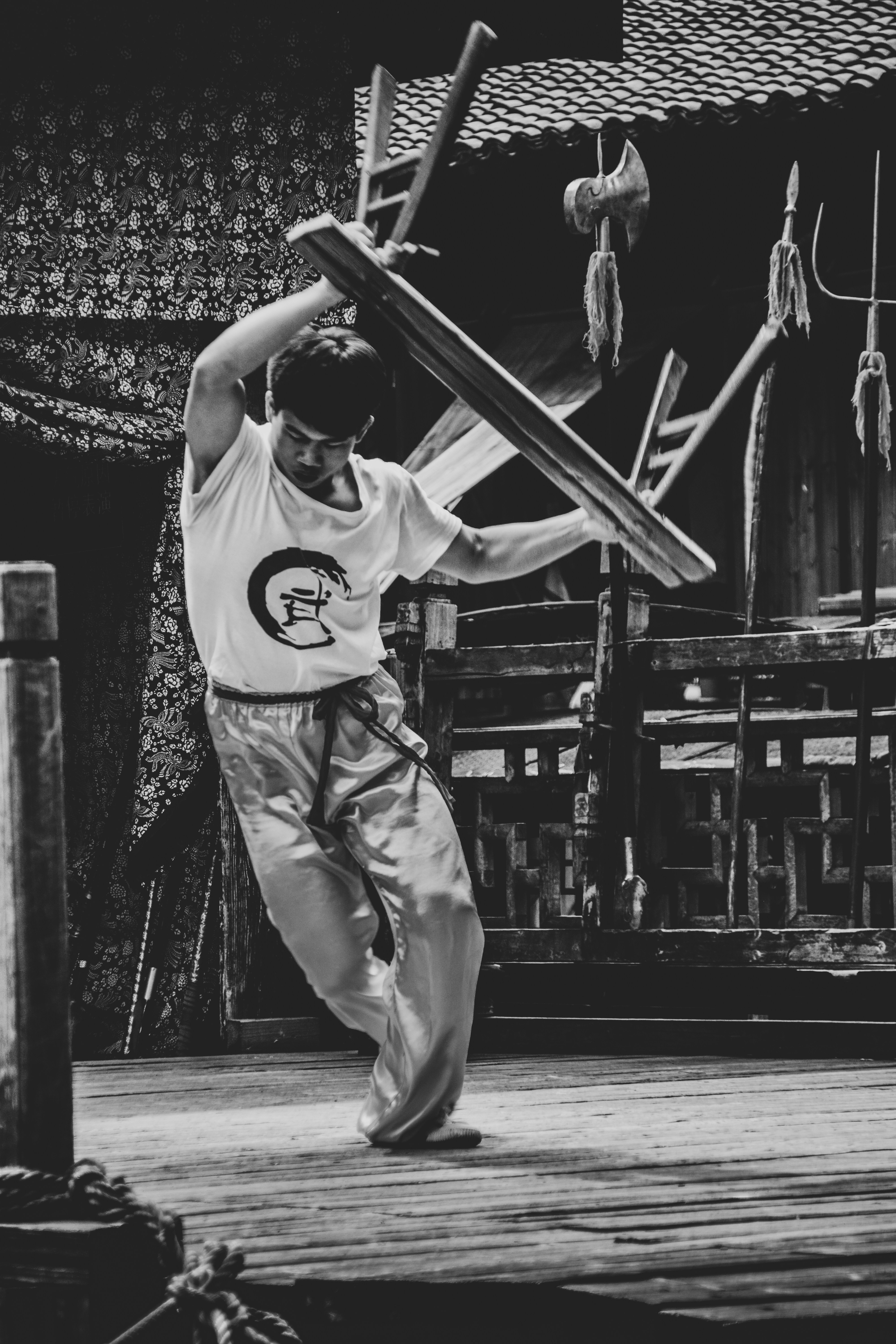Butterfly swords, also known as Butterfly Knives or Baat Jaam Do, are a pair of short, double-edged blades traditionally used in the Chinese martial art of Wing Chun.
These swords hold a unique place in the martial arts world due to their distinct design and application.
Unlike other martial arts weapons, Butterfly Swords are specifically crafted for close-quarter combat, embodying the principles of speed, precision, and efficiency that are central to Wing Chun.
The historical origins of Butterfly Swords can be traced back to the early Qing Dynasty in southern China.
They were initially used by civilians, particularly by those involved in the anti-Qing resistance.
Over time, these swords became integral to the Wing Chun system, which was developed by the legendary martial artists Ng Mui and Yim Wing Chun.
The practicality and effectiveness of Butterfly Swords in real-world combat made them a favored choice among practitioners.
Traditionally, Butterfly Swords are characterized by their relatively short length, typically around 11-15 inches, which allows for swift, fluid movements.
The blades are often slightly curved and feature a hand guard designed to protect the user’s fingers while enabling various blocking and trapping techniques.
This design is particularly advantageous in Wing Chun, where the emphasis is on rapid, close-range strikes and defense.
What sets Butterfly 🦋 Swords apart from other martial arts weapons is their versatility and the ability to be used both offensively and defensively.
The dual-wielding nature of these swords enables practitioners to execute simultaneous attacks and defenses, aligning perfectly with Wing Chun’s philosophy of simultaneous attack and defense.
Additionally, the compact size of Butterfly Swords makes them easier to conceal and maneuver, providing a strategic advantage in combat scenarios.
In essence, Butterfly Swords are not just weapons but an extension of the Wing Chun practitioner’s body and mind.
Their historical significance, unique design, and practical application make them an indispensable part of Wing Chun training, offering both a deep connection to martial arts heritage and a powerful tool for modern self-defense.

The Structure and Design of Butterfly Swords ⚔️
Butterfly swords, also known as “Baat Jaam Do” in Wing Chun, are characterized by their unique and efficient design tailored for close-quarters combat.
These swords are typically shorter than traditional swords, with a blade length ranging from 11 to 14 inches.
This compact size allows for greater maneuverability and swift movements, which are crucial in the Wing Chun fighting style.
The overall weight of butterfly swords varies but generally remains light enough to facilitate quick and agile handling.
A distinctive feature of butterfly swords is the D-guard, a protective handguard that curves around the knuckles.
This guard not only shields the hand from incoming strikes but also enables the wielder to trap and control an opponent’s weapon.
The blades of butterfly swords are notably wide and flat, often with a single sharp edge.
This design allows for both cutting and thrusting techniques, making them versatile in various combat scenarios.
The effectiveness of butterfly swords in combat is significantly enhanced by their structural design.
The wide blades provide a larger surface area for blocking and parrying attacks, while the sharp edge ensures lethal cutting power.
The D-guard contributes to the defensive capabilities of the swords, as it can be used to hook and disarm opponents.
Additionally, the short length of the blades makes it easier to execute rapid, close-range strikes without compromising control.
Butterfly swords are traditionally made from high-quality steel, known for its durability and strength.
Modern versions may incorporate stainless steel or other advanced materials to enhance their resilience and maintain sharpness.
The handles are typically constructed from hardwood or wrapped in leather for a secure grip, ensuring that the swords remain steady in the practitioner’s hands during intense combat situations.
In summary, the structure and design of butterfly swords are meticulously crafted to optimize their performance in Wing Chun practice.
The combination of a compact size, protective D-guard, and wide blades, along with the use of robust materials, makes these swords a formidable tool in martial arts combat.
Training with Butterfly Swords ⚔️

Training with butterfly swords in Wing Chun involves a comprehensive regimen that integrates various exercises, drills, and forms to develop proficiency with these distinctive weapons.
Practitioners engage in a series of conditioning routines aimed at enhancing their coordination, strength, and precision, which are paramount to mastering butterfly swords.
The initial phase of training focuses on fundamental exercises designed to build the foundational skills necessary for handling butterfly swords.
This includes basic grip techniques, stance work, and movements that emphasize fluidity and control.
Beginners often start with solo drills, practicing the different angles of attack and defense to become familiar with the weight and balance of the swords.
As students progress, they incorporate more complex drills that simulate real combat scenarios.
Partner drills are a crucial aspect of this stage, where practitioners engage in controlled sparring to develop timing, distance management, and reactive skills.
These drills are instrumental in honing the ability to transition between offensive and defensive maneuvers seamlessly.
Another critical component of butterfly sword training is the practice of forms, known as “kuen” in Wing Chun.
The most notable form is the Baat Jaam Do, which translates to “Eight Cutting Knives.”
This form encapsulates the essence of butterfly sword techniques and is comprised of a series of choreographed movements that teach practitioners how to execute precise cuts, blocks, and thrusts.
Mastery of the Baat Jaam Do form is essential for any serious student of Wing Chun.
Strength training also plays a vital role in butterfly sword training.
Exercises that target the wrists, forearms, and shoulders are particularly beneficial, as these areas are heavily utilize during swordplay.
Conditioning routines often include weight training, resistance exercises, and repetitive sword drills to build the necessary muscular endurance and power.

Overall, training with butterfly swords requires a balance approach that combines technical skill development, physical conditioning, and strategic understanding.
Through diligent practice and adherence to these training principles, practitioners can achieve a high level of proficiency in wielding butterfly swords within the Wing Chun system.
The butterfly swords, or “Baat Jaam Do” in Cantonese, are a fundamental aspect of Wing Chun, embodying the martial art’s principles of efficiency, precision, and controlled power.
These short, broad-blad weapons require a blend of skill, agility, and strategic thinking.
Central to their effective use are a series of techniques and applications that are meticulously practice to ensure proficiency in both training and real-world self-defense scenarios.
One of the primary techniques with butterfly swords involves mastering a variety of stances.
The neutral stance, often refer to as the “Yi Ji Kim Yeung Ma,” serves as the foundational posture, promoting balance and readiness.
From this stance, practitioners can swiftly transition into offensive or defensive positions.
Strikes with the butterfly swords are executed with precision, targeting vulnerable points on an opponent’s body.
Techniques such as “Duen Da” (short strikes) and “Chang Sao” (long-range strikes) are commonly employee, each tailored to specific combat situations.
Defensive maneuvers are equally crucial, with butterfly swords offering unique blocking and parrying capabilities.
Techniques like “Gum Jarn” (covering arm) and “Tan Da” (deflecting strike) enable practitioners to neutralize attacks while maintaining a strategic advantage.
These maneuvers are designe to deflect incoming strikes and create openings for counterattacks.
Footwork and body movement are integral to the effective execution of these techniques.
The “Biu Ma” (darting step) and “Tui Ma” (retreating step) facilitate dynamic movement, allowing practitioners to close the distance or retreat swiftly as needed.
Coordinating footwork with hand techniques ensures that each strike and block is deliver with maximum efficiency and minimal exposure.
In practice, butterfly sword techniques are often drill through forms and partner exercises.
Forms like the “Baat Jaam Do” form encapsulate a comprehensive range of offensive and defensive techniques, providing a structured approach to mastery.
In real-world self-defense scenarios, these skills translate into decisive, control 🛂 🎛️ actions that can effectively neutralize threats while minimizing harm to both the practitioner and the opponent.
The Role of Butterfly Swords ⚔️ in Wing Chun Philosophy
The butterfly swords, or “Baat Jaam Do,” hold a significant place within the Wing Chun martial arts system, embodying key philosophical principles that are foundational to the discipline.
Central to Wing Chun’s philosophy is the concept of economy of movement.
This principle emphasizes efficiency, minimizing unnecessary motion to deliver powerful, direct techniques.
When training with butterfly swords, practitioners are compelling to refine their movements, as wielding these weapons demands precision and control.

The swords serve as an extension of the practitioner’s body, reinforcing the importance of streamlined actions that conserve energy while maximizing impact.
Another core tenet of Wing Chun is the centerline theory, which posits that the most effective attacks and defenses should be direct along the body’s centerline.
The imaginary line running vertically down the middle of the body.
This theory is vividly illustrate through the use of butterfly swords, as their design and usage encourage continuous focus on this central axis.
The handling of these weapons requires practitioners to maintain an unwavering awareness of their own centerline and that of their opponent.
This heightened focus fosters a deeper understanding of balance and positioning, crucial for both armed and unarmed combat scenarios.
Simultaneous attack and defense is a hallmark of Wing Chun strategy, and butterfly swords training exemplifies this duality.
The dual-wield nature of the swords enables practitioners to execute offensive and defensive maneuvers concurrently.
Enhancing their ability to respond swiftly and effectively to threats.
This simultaneous approach not only increases tactical versatility but also ingrains a mindset of proactive defense.
Where countering an opponent’s move becomes a seamless part of the attack strategy.
Engaging in butterfly swords training amplifies a practitioner’s grasp of these Wing Chun principles.
By integrating the economy of movement, centerline theory.
And simultaneous attack and defense into their practice with these weapons.
Martial artists can achieve a more profound and practical application of Wing Chun’s philosophical foundations.
The butterfly swords thus serve as both a tool and a teacher.
Guiding practitioners towards a more cohesive and effective martial practice.
Famous Practitioners and Masters of Butterfly Swords ⚔️
Throughout the history of Wing Chun, several practitioners and masters have distinguished themselves through their expertise with butterfly swords, also known as Bart Cham Dao.
These individuals have not only Master the art but have also contributed significantly to its proliferation and evolution.
One of the most renowned figures in Wing Chun history is Ip Man.
Ip Man is often credits with popularizing Wing Chun globally, and his proficiency with butterfly swords is legendary.
Born in Foshan, China, he began his training at a young age and later moved to Hong Kong, where his skillset flourishes.
Ip Man’s dedication to the art is example in numerous anecdotes, including stories of his teaching sessions.
He would meticulously demonstrate the intricacies of butterfly sword techniques to ensure his students understood their importance.
Another eminent master is Wong Shun Leung, a direct student of Ip Man.

Known for his combative prowess, Wong Shun Leung earned the nickname “King of Talking Hands.”
His expertise with butterfly swords was unparalleled.
And he was instrumental in refining the techniques and applications of these weapons.
Wong’s practical approach to Wing Chun, including his butterfly sword techniques, has influences countless practitioners worldwide.
Leung Ting, a contemporary Wing Chun master, is also celebrates for his expertise with butterfly swords.
As a grandmaster and founder of the International Wing Tsun Association, Leung Ting has authored numerous books and instructional videos.
Bringing the nuanced techniques of butterfly swords to a global audience.
His dedication to preserving and expanding Wing Chun knowledge has been inspirational to many.
Bruce Lee, although more widely recognized for his contributions to martial arts cinema and Jeet Kune Do, also has roots in Wing Chun.
As a student of Ip Man, Lee’s early training include the use of butterfly swords ⚔️.
And his innovative approach to martial arts was undoubtedly influences by this foundational knowledge.
These masters, with their exceptional skills and unwavering dedication, have not only master the butterfly swords ⚔️.
But have also ensures that this traditional weapon continues to be an integral part of Wing Chun practice.
Their legacies inspire current and future generations to uphold the art with the same passion and precision.
Modern Adaptations and Usage of Butterfly 🦋 Swords ⚔️
The butterfly swords, traditionally associated with Wing Chun and other Chinese martial arts.
Butterfly 🦋 Sword 🗡️ have found a place in contemporary martial arts and self-defense training.
In today’s practice, these iconic weapons are not only preserves for their historical value but also enhances with modern design adaptations to meet current needs.
One of the most notable modern adaptations of butterfly swords lies in their design.
Contemporary versions often feature lighter materials, such as high-grade stainless steel or aluminum.
Making them more accessible for practitioners of different skill levels.
Additionally, ergonomic handles and improved blade balance contribute to better control and maneuverability during training and combat scenarios.
In the realm of martial arts, butterfly swords are employees in various training programs that emphasize self-defense techniques.
Their compact size and dual-wielding capability make them ideal for close-quarter combat.
Instructors often integrate these swords into drills that focus on quick strikes, blocks.
And disarming techniques, thereby providing students with practical skills applicable to real-world self-defense situations.
Moreover, butterfly swords have gained prominence in martial arts competitions and demonstrations.
Events showcasing traditional forms and modern sparring often feature the use of these swords.
Highlighting their aesthetic appeal and the technical prowess required to wield them effectively.
These performances not only honor the historical legacy of butterfly swords but also illustrate their relevance in contemporary martial practice.
Popular culture has also embraces butterfly swords, further cementing their status in the modern era.
Movies and television series frequently depict characters using these weapons.
Often in high-action sequences that capture the imagination of audiences.
This exposure has spark a renew interest in butterfly swords.
Drawing new enthusiasts to explore their rich history and practical applications in martial arts.
Overall, the modern adaptations and usage of butterfly swords reflect a blend of tradition and innovation.
Ensuring that these iconic weapons continue to thrive in the dynamic landscape of contemporary martial arts and self-defense.
Getting Started with Butterfly Swords ⚔️
Embarking on the journey to master butterfly swords in Wing Chun is both an exciting and challenging endeavor.
For beginners, it is essential to find a qualifying instructor who can provide expert guidance and ensure proper technique.
Look for instructors who have extensive experience in Wing Chun and a deep understanding of butterfly swords.
Personal recommendations, online reviews, and verified certifications can be valuable resources in your search.
Selecting the right equipment is another crucial step.
Butterfly swords come in various sizes, weights, and materials.
As a beginner, opt for a pair that is well-balance and not too heavy.
This will help you develop your skills without unnecessary strain.
Many practitioners recommend starting with wooden or pad practice swords to minimize the risk of injury.
As you progress, you can transition to metal swords that are designe specifically for Wing Chun.
Setting realistic training goals is vital for maintaining motivation and tracking progress.
Begin by focusing on the basics, such as proper grip, stance, and simple maneuvers.
It is important to build a strong foundation before attempting more advanced techniques.
Consistency is key, so establish a regular training schedule that fits your lifestyle.
Remember, the journey to proficiency with butterfly swords is a marathon, not a sprint.
Patience and dedication are your best allies on this path.
Mastering butterfly swords in Wing Chun requires time and effort.
So do not be discourage by initial challenges or slow progress.
Celebrate small victories and stay committed to your practice.
Surround yourself with a supportive community, whether it is fellow students or online forums.
To share experiences and gain encouragement.
Starting your journey with butterfly swords in Wing Chun is a rewarding pursuit that combines physical skill, mental discipline, and historical tradition.
With the right instructor, equipment, and mindset.
You can develop proficiency and enjoy the many benefits that come with mastering this unique martial art.



